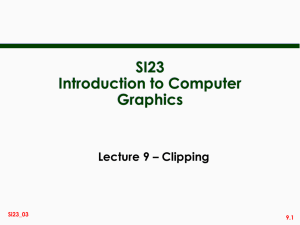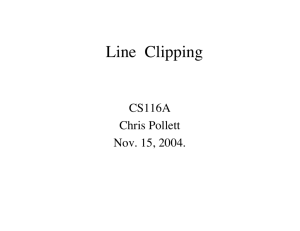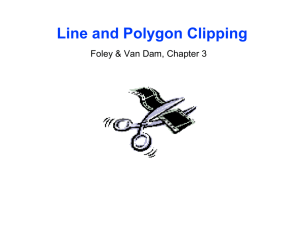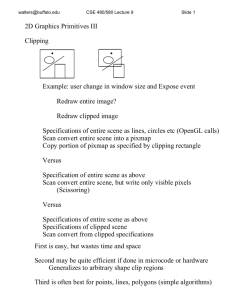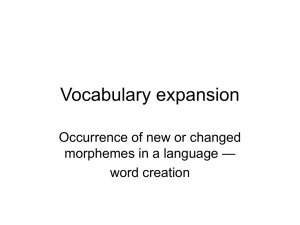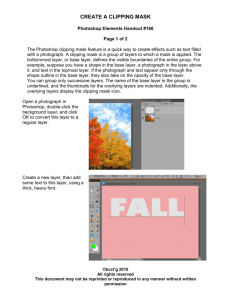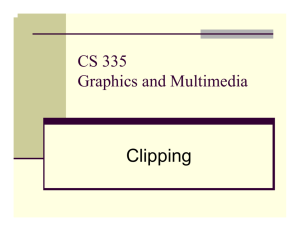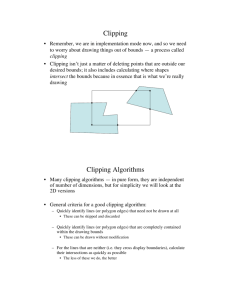Line Clipping - Computer Science and Engineering
advertisement
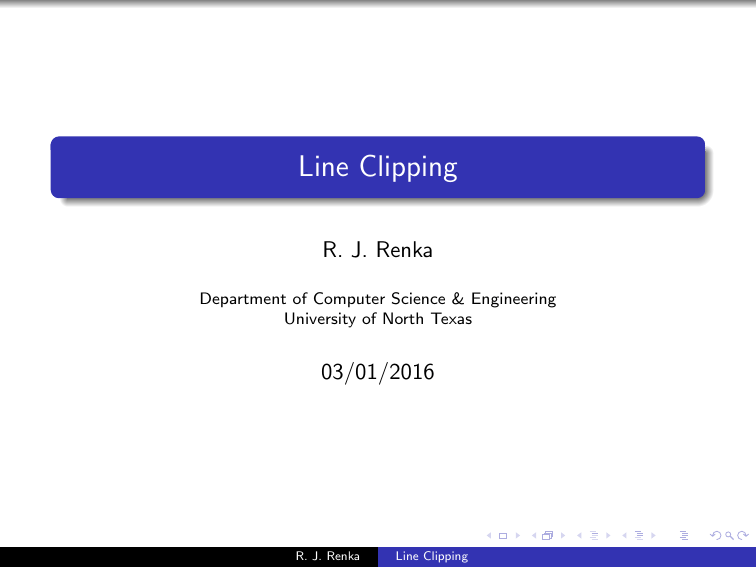
Line Clipping
R. J. Renka
Department of Computer Science & Engineering
University of North Texas
03/01/2016
R. J. Renka
Line Clipping
Problem
The clipping problem is that of finding the portion of a geometric
primitive (point, line, or polygon) that lies inside a view volume.
For points, it is just a containment test; lines require computing
intersections of line segments with view volume boundaries; and
polygons, defined by sequences of vertices, involve additional
complexity associated with keeping track of the order of the
vertices.
2-D Line-clipping Problem: Given a line segment defined by p0
and p1 in R2 , and a rectangular clip window [Xmin , Xmax ]×
[Ymin , Ymax ], clip the line segment against the window; i.e., replace
the line segment by its intersection with the window.
The general problem of finding the intersection of a pair of line
segments is not trivial. It is much simpler to intersect a line
segment with a horizontal or vertical line defined by constant y or
constant x.
R. J. Renka
Line Clipping
Cohen-Sutherland Line Clipping Algorithm
We partition the plane into nine regions by extending the four clip
window boundaries to infinity in both directions, and then assign
4-bit region codes or outcodes to the regions by arbitrarily ordering
the boundaries. The diagram on the following page is associated
with the checking order TBRL, corresponding to Top, Bottom,
Right, Left. We assign a 1-bit where the region is strictly outside
the boundary (in the half-plane not containing the window), and a
0-bit where the region is on the same side as the window. Thus,
only the window itself is assigned all zeros. Since the high-order bit
is associated with the top boundary for example, only the three
regions above the window (outside the top boundary) have
high-order bit equal to 1.
Top
Bottom
Right
Left
b3
b2
b1
b0
= sign(Ymax − y )
= sign(y − Ymin )
= sign(Xmax − x)
= sign(x − Xmin )
R. J. Renka
Line Clipping
Cohen-Sutherland Line Clipping Example
1001
1010
s
p1
s
1000
Ymax
0001
C
s
0010
0000
B
s
Ymin
A
s
0101
p0
Xmin
0110
Xmax
p0 − p1 −→ A − p1 −→ A − C −→ A − B
R. J. Renka
Line Clipping
Cohen-Sutherland Line Clipping Algorithm
Assign region codes c0 to p0 and c1 to p1
while (1) {
if (c0 | c1 == 0) break;
if (c0 & c1 != 0) {
Set the line segment to the empty set
break;
}
c = (c0 != 0) ? c0 : c1;
Test the bits of c in left-to-right order to find which
boundary is crossed, and find the intersection point
Replace the outside point by the intersection point,
and compute the new region code by zeroing the
appropriate bits
}
Draw the line segment
R. J. Renka
Line Clipping
Cohen-Sutherland Line Clipping Algorithm continued
The algorithm is efficient when region code testing is cheap and
most line segments are trivially rejected due to a relatively small
window, or accepted without alteration due to a relatively large
window. In the example, three intersections are computed when
only two are actually needed. A worst-case example requires four
intersections. The Liang-Barsky parametric line clipping algorithm
is more efficient when a lot of clipping is needed.
Both algorithms are easily generalized to 3-D. To extend the
Cohen-Sutherland algorithm to a three-dimensional orthogonal
view volume (a rectangular box), we use 6-bit region codes with
additional bits for the near and far clipping planes. Then the
worst-case line segment requires computation of six intersections.
A frustum is also defined by six planar boundaries but, because the
planes are not axis-aligned (defined by constant x, y, or z), region
code assignment and intersection computations are more expensive.
R. J. Renka
Line Clipping
Computing Intersections
To find the intersection with the left or right boundary, we write y
as the linear function of x that interpolates the endpoints, and
plug in x = Xmin or x = Xmax . For p0 = (x0 , y0 ) and p1 = (x1 , y1 ),
the intersection with the left boundary is
(Xmin , y0 + m(Xmin − x0 )),
where the slope is m = (y1 − y0 )/(x1 − x0 ). Note that, if x1 − x0
were 0, we would not have found an intersection with a vertical
boundary. To find the intersection with the top or bottom
boundary, we reverse the roles of x and y ; i.e., write x as the linear
function of y that interpolates the endpoints, and plug in
y = Ymax or y = Ymin .
R. J. Renka
Line Clipping
Intersection of a Line Segment with a Clipping Plane
To find the intersection of p0 − p1 with the plane z = Zmin , we
write x and y as interpolatory linear functions of z
x = x0 +
y1 − y0
x1 − x0
(z − z0 ), y = y0 +
(z − z0 ),
z1 − z0
z1 − z0
and substitute z = Zmin . As an alternative derivation, the
parametric representation of the line segment is
S = {p0 + t(p1 − p0 ) : t ∈ [0, 1]} ⊂ R3 .
Thus, p = (x, y , z) ∈ S ⇒ x = x0 + t(x1 − x0 ),
y = y0 + t(y1 − y0 ), and z = z0 + t(z1 − z0 ) for t ∈ [0, 1]. To find
S ∩ {(x, y , z) : z = Zmin }, assuming z1 6= z0 , we solve
z = Zmin = z0 + t(z1 − z0 ) for t = (Zmin − z0 )/(z1 − z0 ), which
gives the same expressions derived above:
x = x0 +
Zmin − z0
Zmin − z0
(x1 − x0 ), y = y0 +
(y1 − y0 ).
z1 − z0
z1 − z0
R. J. Renka
Line Clipping
Liang-Barsky Line Clipping Algorithm
Parametric representation: v = v0 + u(v1 − v0 )
t0 = 0, t1 = 1, dx = x1-x0, dy = y1-y0
for each boundary b in {Left, Right, Bottom, Top}
if (b == Left) p = -dx, q = -(Xmin-x0)
if (b == Right) p = dx, q = Xmax-x0
if (b == Bottom) p = -dy, q = -(Ymin-y0)
if (b == Top) p = dy, q = Ymax-y0
u = q/p
// Parameter value of b
if (p == 0)
// Line parallel to b
if (q < 0) return false
// Reject line segment
elseif (p < 0)
// Outside to inside
if (u > t1) return false
if (u > t0) t0 = u
// Clip
else
// Inside to outside
R. J. Renka
Line Clipping
Liang-Barsky Line Clipping Algorithm
if (u < t0) return false
if (u < t1) t1 = u
// Clip
end
end
x0 = x0 + t0*dx, y0 = y0 + t0*dy
x1 = x0 + t1*dx, y1 = y0 + t1*dy
return true
R. J. Renka
Line Clipping


